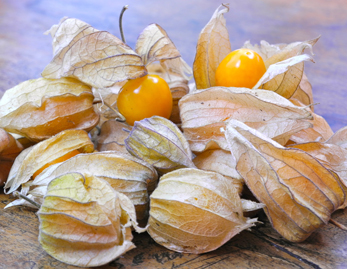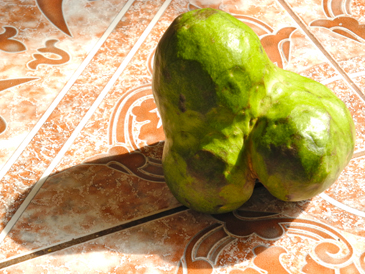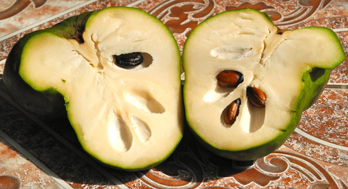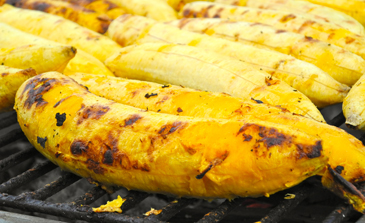Paleo Foods: Andean Fruits
 Sunday, May 29, 2011 at 04:18PM
Sunday, May 29, 2011 at 04:18PM Guest Post by John Michael
 One of the dilemmas that people face when switching to the Paleo diet is an apparent loss of variety in what they can eat. By becoming Paleo, we leave behind a great number of foods that human ingenuity has fashioned from the products of the Agricultural Revolution; whether it’s the grain-based cereals that we’ve become accustomed to eating in the morning, or the dairy-based desserts that send us off to bed at night, there’s a lot that we leave behind. But, in my experience with switching to the Paleo Diet, I’ve found that, instead of having my culinary horizons narrowed, this diet has actually revealed to me the great number of foods and flavors that exist outside of the realms of grains, dairy products, and heavily processed foods. These blogs, which will all be entitled Paleo Foods, are an attempt to share the diversity of the delightful flavors that can be found within the alimentary domains of fruits, vegetables, meats, and nuts and oils, which together form the basic components of the Paleo Diet.
One of the dilemmas that people face when switching to the Paleo diet is an apparent loss of variety in what they can eat. By becoming Paleo, we leave behind a great number of foods that human ingenuity has fashioned from the products of the Agricultural Revolution; whether it’s the grain-based cereals that we’ve become accustomed to eating in the morning, or the dairy-based desserts that send us off to bed at night, there’s a lot that we leave behind. But, in my experience with switching to the Paleo Diet, I’ve found that, instead of having my culinary horizons narrowed, this diet has actually revealed to me the great number of foods and flavors that exist outside of the realms of grains, dairy products, and heavily processed foods. These blogs, which will all be entitled Paleo Foods, are an attempt to share the diversity of the delightful flavors that can be found within the alimentary domains of fruits, vegetables, meats, and nuts and oils, which together form the basic components of the Paleo Diet.
I’ve encountered many new fruits during my travels through the Andean mountains, and in this blog post I’m going to share with you three of my favorites.
The Cherimoya
 Although at first sight I thought that the cherimoya would be hard and stiff to the touch, when I got the chance to examine one, I found it to be quite soft, giving below the slightest pressure of my fingers. When I opened my cherimoya by cutting it down the middle with a knife, and so revealing the fruit’s pale white flesh and its dark brown seeds, I detected a faintly sweet smell that was very familiar, but which I couldn’t immediately place. It was only when I took a bite of the smooth and velvety flesh of the cherimoya that I realized that this was the exact same flavor that I had encountered in those Skittles and Starbusts which claimed to be banana flavored, but which had a both distinctly and intriguingly non-banana taste. The consistency of the cherimoya flesh was somewhere between fibrous and gelatinous, and at the same time that it reminded me of bubblegum, it also seemed to melt in my mouth. As I continued to eat, I found the cherimoya to be both exquisitely sweet and slightly tangy, and the experience of consuming it became so pleasurable that I quickly regretted that I had bought such a small cherimoya, even though the fruit that I had purchased was larger than both of my fists put together.
Although at first sight I thought that the cherimoya would be hard and stiff to the touch, when I got the chance to examine one, I found it to be quite soft, giving below the slightest pressure of my fingers. When I opened my cherimoya by cutting it down the middle with a knife, and so revealing the fruit’s pale white flesh and its dark brown seeds, I detected a faintly sweet smell that was very familiar, but which I couldn’t immediately place. It was only when I took a bite of the smooth and velvety flesh of the cherimoya that I realized that this was the exact same flavor that I had encountered in those Skittles and Starbusts which claimed to be banana flavored, but which had a both distinctly and intriguingly non-banana taste. The consistency of the cherimoya flesh was somewhere between fibrous and gelatinous, and at the same time that it reminded me of bubblegum, it also seemed to melt in my mouth. As I continued to eat, I found the cherimoya to be both exquisitely sweet and slightly tangy, and the experience of consuming it became so pleasurable that I quickly regretted that I had bought such a small cherimoya, even though the fruit that I had purchased was larger than both of my fists put together.

The only downside to my cherimoya experience was a bitter aftertaste, which seemed to cling to my tongue, erasing my memories of the cherimoya’s earlier sweetness. “Perhaps that’s what I get for buying fruit off a wheelbarrow on a street corner,” I thought to myself. But bitter or not, I didn’t give up on the cherimoya; instead, I let my second half sit out in the air for a few hours, after which I found it to be markedly less bitter. This lack of bitterness I attributed to either of two possibilities: either the fruit’s bitterness had lessened because its flesh was exposed to the open air for several hours, or perhaps I just became accustomed to the taste. I later asked a woman who I saw on the street selling fruit why it was that my cherimoya had had such a bitter aftertaste, and she told me that cherimoyas have to be eaten right when they ripen, when they’re still a fresh green, and before any brown or black marks begin to mar the skin of the fruit or to stain its pale-white flesh. (The cherimoya that I had purchased had several brown marks near its base.) Now that I know that the bitter aftertaste is avoidable, I have my eyes peeled for the perfectly ripe cherimoya.
With regards to its nutritional value, according to the USDA’s Nutrient Database, the cherimoya is a great source of potassium, as well as containing a moderate amount of vitamin C and dietary fiber. For myself, this fruit represents the perfect dessert or mid-day treat, and I currently find myself daring to wonder whether the satisfying sweetness of the cherimoya’s flesh could be driven to even higher realms of taste-bud gratification with perhaps just a drop or two of honey.
Aguaymantos
 When I lived on Comuna de Rhiannon, there was always a bowlful of tangy and orange-yellow aguaymantos on the kitchen table, and whoever wanted to could take a handful as they passed and munch on this delicious fruit as they went about their daily work on the commune. While it was on Comuna de Rhiannon that I first encountered this berry, Lisa, a young British woman who was also staying on the commune at the time, told me that aguaymantos were a delicacy in Britain, where they often garnished desserts in the more upscale restaurants of that country. This same practice is followed in Lima, Peru, where the aguaymanto is usually featured several times on dessert menus in middle-to-high-end restaurants; but, curiously, the aguaymanto always appears as an adornment of the dessert, and never as the main flavor of the dish, which, considering this Andean berry’s marvelous taste, I find to be quite the missed culinary opportunity.
When I lived on Comuna de Rhiannon, there was always a bowlful of tangy and orange-yellow aguaymantos on the kitchen table, and whoever wanted to could take a handful as they passed and munch on this delicious fruit as they went about their daily work on the commune. While it was on Comuna de Rhiannon that I first encountered this berry, Lisa, a young British woman who was also staying on the commune at the time, told me that aguaymantos were a delicacy in Britain, where they often garnished desserts in the more upscale restaurants of that country. This same practice is followed in Lima, Peru, where the aguaymanto is usually featured several times on dessert menus in middle-to-high-end restaurants; but, curiously, the aguaymanto always appears as an adornment of the dessert, and never as the main flavor of the dish, which, considering this Andean berry’s marvelous taste, I find to be quite the missed culinary opportunity.
Before you can eat an aguaymanto, you have to remove the leafy cover that protects it. This cover is not edible, though it does have a pleasurable texture, which reminds me of the natural paper that one finds in handmade journals, that brownish paper which often has thin flecks of bark and leaves stuck to it. Once the aguaymanto’s cover is removed, it’s merely a matter of twisting the berry off of its stem, and then popping it into your mouth. It’s tart, but not in any way bitter, and its tartness quickly becomes smooth, and almost, but not quite, creamy, with a background of sweetness soon appearing that protects the tongue from any discomfort which further tartness might have caused. The berry has a smooth and firm carapace that can be somewhat sticky depending on the amount of time that has passed between its harvest and consumption – the more time that has passed since its picking, the stickier you may find the berry to be, and the juice that an over-ripened berry can exude may lead you to the sink to wash your hands after eating only a handful. Aguaymantos begin a tomato-green color, and then slowly ripen to a lustrous yellow-orange. This is the color that I prefer my aguaymanto’s to be before I eat them, because I find that their flavor is richest at this point. When they begin to darken in color, losing their vivid orange-yellow as their skin softens, I generally throw them out, because I find that the taste at this point can become somewhat sour and unpleasant.
Unfortunately, the aguaymanto didn’t show up on the USDA’s nutrient database, but, according to the website Yanuq: Cooking in Peru, the aguaymanto “is one of the most abundant sources of vitamin C available among all plants and fruits,” and “contains as much as 20 times… vitamin C as that in an orange.” As far as I’m concerned, the aguaymanto is the perfect snack if you’re on the go; they’re quick, easy, and extremely tasty.
Grilled Plantain
 When pronouncing the word plantain, some people say plan-ten, while others say plan-tane. But when it comes to me, I don’t say either. Instead, when I see an Ecuadorian standing over a portable grill covered in plantains, only one word comes to my mouth, and it’s not platano. It’s “rico,” the Latin American Spanish equivalent of “delicious,” and it usually comes to my lips after a long and heartfelt “mmm.” Although to myself they seem denser than bananas, according to Wikipedia, “There is no formal botanical distinction between bananas and plantains, and the use of either term is based purely on how the fruits are consumed.” Which is to say that, although it’s not included on Dr. Loren Cordain’s list of acceptable foods in The Paleo Diet, the plantain is Paleo.
When pronouncing the word plantain, some people say plan-ten, while others say plan-tane. But when it comes to me, I don’t say either. Instead, when I see an Ecuadorian standing over a portable grill covered in plantains, only one word comes to my mouth, and it’s not platano. It’s “rico,” the Latin American Spanish equivalent of “delicious,” and it usually comes to my lips after a long and heartfelt “mmm.” Although to myself they seem denser than bananas, according to Wikipedia, “There is no formal botanical distinction between bananas and plantains, and the use of either term is based purely on how the fruits are consumed.” Which is to say that, although it’s not included on Dr. Loren Cordain’s list of acceptable foods in The Paleo Diet, the plantain is Paleo.
The grilled plantain has a flavor that is rich, and somewhat savory, although there is a hint of sweetness in the aftertaste, and it is there, but only there, that the plantain recalls the taste profile of its more familiar cousin, the banana. Almost succulent in its consistency, the plantain is less fibrous than the banana, and much heartier; grilled plantain is the kind of food that sticks to your ribs. Its flesh is soft, but not so soft as a banana, and this leads to just the right amount of chewiness, which is to say, only so much chewiness as to make eating the plantain a pleasure, but not a chore. Some people prefer to fry their plantains, but, although this is also delicious, I find that the oil that impregnates the fruit detracts from the subtle and natural flavors of the plantain. A Colombian friend once told me that plantains can make you fat if you eat too many; while I haven’t found this to be the case, it might apply, if at all, more to fried than to grilled plantains, and be due to the oil that is used to cook them. I often encounter myself eating grilled plantains in between meals, finding them an excellent way to stave off any unexpected hunger.
While the USDA’s nutrient database displays plantains as an excellent source of potassium, the website Self Nutrition Data also adds that the plantain “is a good source of Vitamin A, Vitamin C, [and] Vitamin B6,” although it does go on to warn that, “A large portion of the calories in this food come from sugars.” The plantain is a rich and savory way to calm your hunger in between meals; all in all, it’s a completely satisfying snack.
 Andean fruit,
Andean fruit,  aguaymanto,
aguaymanto,  cherimoya,
cherimoya,  grilled plantain in
grilled plantain in  Paleo Foods
Paleo Foods 


Reader Comments (1)
Dear god, get that plantane in my face right now!